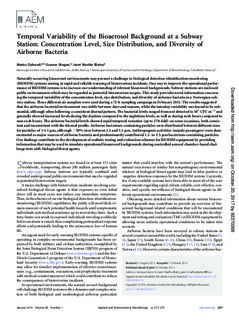| dc.contributor.author | Dybwad, Marius | |
| dc.contributor.author | Skogan, Gunnar | |
| dc.contributor.author | Blatny, Janet Martha | |
| dc.date.accessioned | 2017-10-23T08:33:20Z | |
| dc.date.available | 2017-10-23T08:33:20Z | |
| dc.date.created | 2014-04-01T12:43:42Z | |
| dc.date.issued | 2014 | |
| dc.identifier.citation | Applied and Environmental Microbiology. 2014, 80 (1), 257-270. | nb_NO |
| dc.identifier.issn | 0099-2240 | |
| dc.identifier.uri | http://hdl.handle.net/11250/2461398 | |
| dc.description.abstract | Naturally occurring bioaerosol environments may present a challenge to biological detection-identification-monitoring (BIODIM) systems aiming at rapid and reliable warning of bioterrorism incidents. One way to improve the operational performance of BIODIM systems is to increase our understanding of relevant bioaerosol backgrounds. Subway stations are enclosed public environments which may be regarded as potential bioterrorism targets. This study provides novel information concerning the temporal variability of the concentration level, size distribution, and diversity of airborne bacteria in a Norwegian subway station. Three different air samplers were used during a 72-h sampling campaign in February 2011. The results suggested that the airborne bacterial environment was stable between days and seasons, while the intraday variability was found to be substantial, although often following a consistent diurnal pattern. The bacterial levels ranged from not detected to 103 CFU m3 and generally showed increased levels during the daytime compared to the nighttime levels, as well as during rush hours compared to non-rush hours. The airborne bacterial levels showed rapid temporal variation (up to 270-fold) on some occasions, both consistent and inconsistent with the diurnal profile. Airborne bacterium-containing particles were distributed between different sizes for particles of >1.1 m, although 50% were between 1.1 and 3.3 m. Anthropogenic activities (mainly passengers) were demonstrated as major sources of airborne bacteria and predominantly contributed 1.1- to 3.3-m bacterium-containing particles. Our findings contribute to the development of realistic testing and evaluation schemes for BIODIM equipment by providing information that may be used to simulate operational bioaerosol backgrounds during controlled aerosol chamber-based challenge tests with biological threat agents. | nb_NO |
| dc.language.iso | eng | nb_NO |
| dc.publisher | American Society for Microbiology (ASM) | nb_NO |
| dc.title | Temporal variability of the bioaerosol background at a subway station: Concentration level, size distribution, and diversity of airborne bacteria | nb_NO |
| dc.type | Journal article | nb_NO |
| dc.type | Peer reviewed | nb_NO |
| dc.description.version | publishedVersion | nb_NO |
| dc.source.pagenumber | 257-270 | nb_NO |
| dc.source.volume | 80 | nb_NO |
| dc.source.journal | Applied and Environmental Microbiology | nb_NO |
| dc.source.issue | 1 | nb_NO |
| dc.identifier.doi | 10.1128/AEM.02849-13 | |
| dc.identifier.cristin | 1126385 | |
| dc.relation.project | Forsvarets forskningsinstitutt: 1327 | nb_NO |
| dc.description.localcode | Copyright © 2014 American Society for Microbiology. All Rights Reserved. | nb_NO |
| cristin.unitcode | 194,66,15,0 | |
| cristin.unitname | Institutt for bioteknologi og matvitenskap | |
| cristin.ispublished | true | |
| cristin.fulltext | original | |
| cristin.qualitycode | 2 | |
